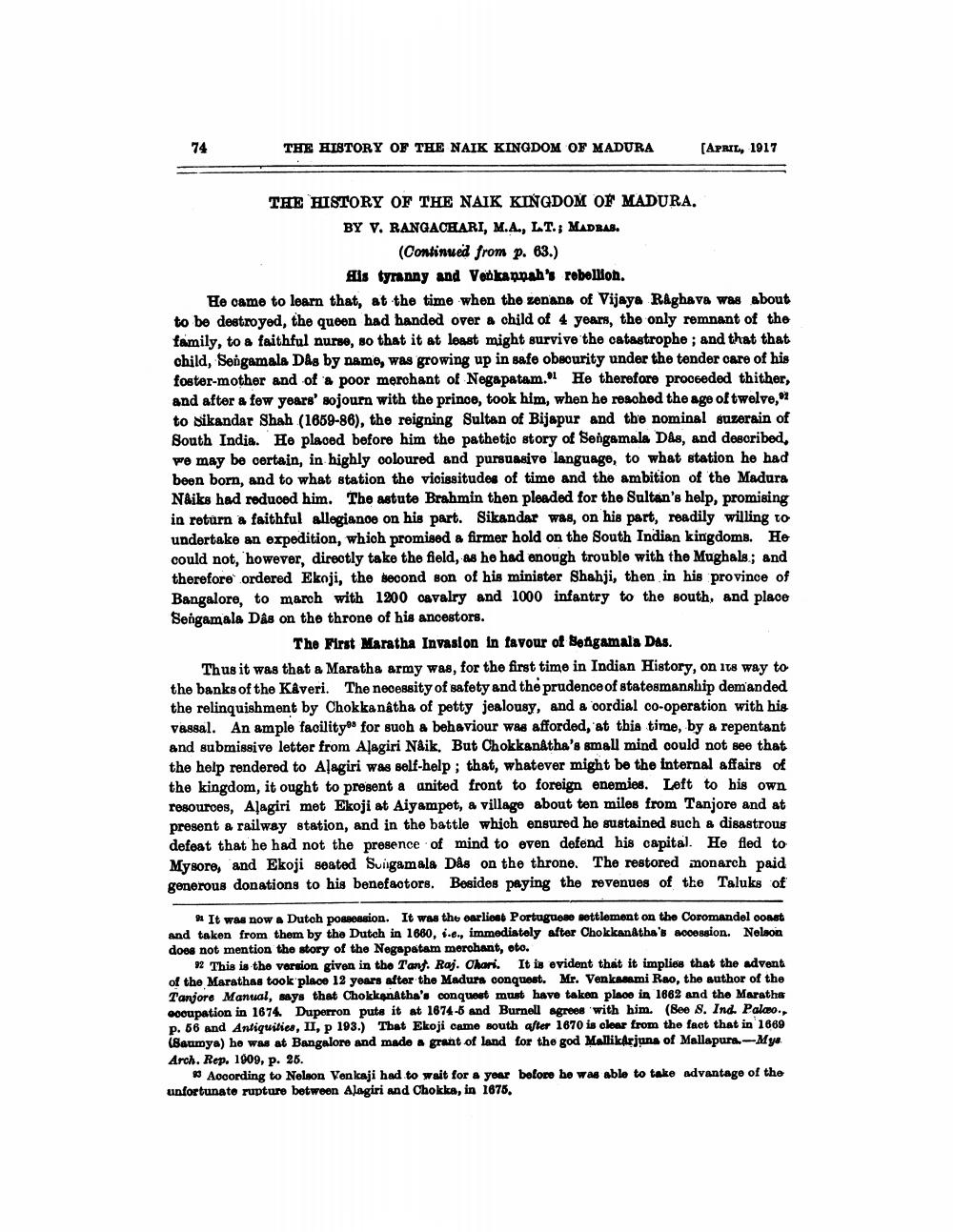________________
THE HISTORY OF THE NAIK KINGDOM OF MADURA
[APRIL, 1917
THE HISTORY OF THE NAIK KINGDOM OF MADURA.
BY V. RANGACHARI, M.A., LT.; MADRAS.
(Continued from p. 83.)
Alls tyranny and Venkappah's rebellion. He came to learn that, at the time when the zenana of Vijaya Raghava was about to be destroyed, the queen had handed over a child of 4 years, the only remnant of the family, to a faithful nurse, so that it at least might survive the catastrophe; and that that child, Sengamala Dås by name, was growing up in safe obecurity under the tender care of his foster-mother and of & poor merchant of Negapatam. He therefore proceeded thither, and after a few years' sojourn with the prince, took him, when he reached the age of twelve, to sikandar Shah (1659-86), the reigning Sultan of Bijapur and the nominal suzerain of South India. He placed before him the pathetic story of Sengamala Dås, and described we may be certain, in highly coloured and pursuasive language, to what station he had been born, and to what station the vicissitudes of time and the ambition of the Madura Naiks had reduced him. The astute Brahmin then pleaded for the Sultan's help, promising in return a faithful allegiance on his part. Sikandar was, on his part, readily willing to undertake an expedition, which promised a firmer hold on the South Indian kingdoms. He could not, however, directly take the field, as he had enough trouble with the Mughals.; and therefore ordered Ekoji, the second son of his minister Shahji, then in his province of Bangalore, to march with 1200 oavalry and 1000 infantry to the south, and place Sengamala Dås on the throne of his ancestors.
The First Maratha Invasion in favour of Bengamala Das. Thus it was that a Maratha army was, for the first time in Indian History, on 178 way to the banks of the Køveri. The necessity of safety and the prudence of statesmanship demanded the relinquishment by Chokka nátha of petty jealousy, and a cordial co-operation with his Vassal. An ample facility for suoh a behaviour was afforded, at this time, by a repentant and submissive letter from Alagiri Naik, But ChokkanAtha's small mind could not see that the help rendered to Alagiri was self-help ; that, whatever might be the internal affairs of the kingdom, it ought to present a united front to foreign enemies. Left to his own resources, Alagiri met Ekoji at Aiyampet, & village about ten miles from Tanjore and at present a railway station, and in the battle which ensured he sustained such a disastrous defeat that he had not the presence of mind to even defend his capital. He fled to Mysore, and Ekoji seated Suigamala Dâs on the throne. The restored monarch paid generous donations to his benefactors. Besides paying the revenues of the Taluks of
It was now a Dutch possession. It was the earliest Portuguese settlement on the Coromandel oonst and taken from them by the Dutch in 1660, i.e., immediately after Chokkanatha's accossion. Nelson does not mention the story of the Negapatam merchant, oto.
12 This is the version given in the Tany. Raj. Chari. It is evident that it implies that the advent of the Marathas took place 12 years after the Madura conquest. Mr. Venkaasmi Rao, the author of the Tanjore Manual, says that ChokkanAtha's conquest must have taken place in 1862 and the Maraths cocupation in 1674 Duperron puts it at 1674-5 and Burnell agrees with him. (Bee 8. Ind. Palao. P. 56 and Antiquities, II, p 193.) That Ekoji came south after 1670 is clear from the fact that in 1669 (Saumya) he was at Bangalore and made a grant of land for the god Mallikarjuna of Mallapura-Mye Arch. Rep. 1909, p. 26.
According to Nelson Venkaji had to wait for a year before he was able to take advantage of the unfortunate rupture between Alagiri and Chokka, in 1875.




